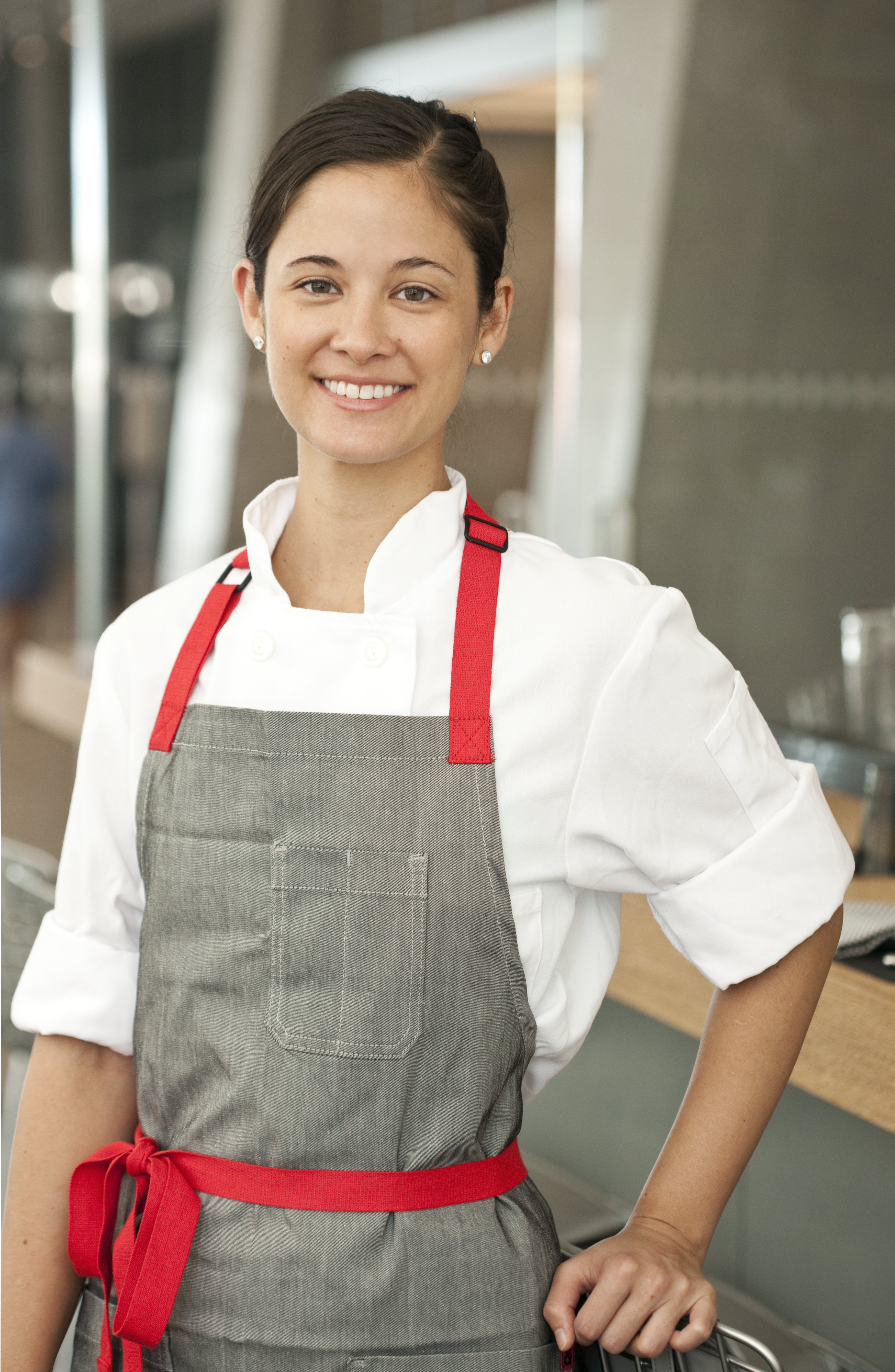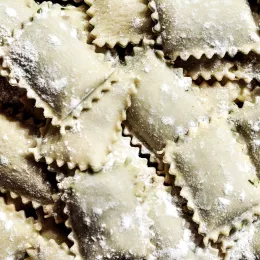In a dining room on the ground floor of the Whitney Museum, where an open kitchen sits across from a towering glass wall and not an inch can escape the natural sunlight, I met with Suzanne Cupps (Culinary Arts, ’05), executive chef of Untitled. With a menu featuring colorful contemporary American cuisine, Untitled has enjoyed warm critical reviews, including a place on the New York Times “Critic’s Pick” list.
Suzanne has played no small part in the restaurant’s success. Though she began at ICE without knowing how to hold a knife, Suzanne, a former math major, was a disciplined student and a quick learner. By the time she graduated, she was ready for the New York restaurant scene and earned her stripes in the kitchens of Annisa and Gramercy Tavern before landing a gig as chef de cuisine at the buzzy new meatpacking restaurant, Untitled.
Recently, Suzanne scored the enviable position of executive chef, not to mention the right to call the restaurant her own — something she does with a discernible note of pride in her voice. She’s transitioned from top student to head teacher, creating not only a menu, but also an atmosphere from the top down, one that allows for questions, experimenting, mistakes, and ultimately, learning — more learning, Suzanne thinks, than the traditional, chef-as-dictator style.

On a recent Wednesday afternoon, Suzanne took a quick break before dinner prep to chat with me for the ICE blog.
First, congratulations on your promotion to executive chef of Untitled! What are the changes that go with this new title?
Michael Anthony [Managing Director of Untitled, as well as Executive Chef and Partner of Gramercy Tavern] is very trusting, so he allowed me to know about financials and hiring and the other management things when I was chef de cuisine. With his help, I was running the restaurant already.
I think the biggest difference is that Mike’s not here anymore. It wasn’t that I took over a bunch of different duties. It’s just that now the responsibility of making sure the business succeeds falls on my shoulders. I was invested as chef de cuisine, but now even more so because it’s my restaurant.
Do you still get to spend time in the kitchen? Oh yes, definitely: I’m actually working the grill station tonight. In fact, I think that’s the hardest part about the job — there’s a lot of emails and paperwork but I try to spend as much time in the kitchen as I can. I would say on a normal day, I spend 70% of my time in the kitchen.
What does a “day in the life” typically look like for you?
There’s a lot of running around. One of the things that’s unique and challenging about our space is that we’re located on three floors. Untitled is here on the ground floor, our prep kitchen is two floors down and then we have another restaurant, Studio Café, on the 8th floor. That separation can be a challenge — to be in the right place at the right time.
My job is a lot about being available. I have a list of things I need to do and only about 20% of that gets done because I get pulled around. Sometimes it’s a busy service and they need extra hands, sometimes a meeting pops up, or I have to sit and chat with an employee, or work on a special. I get pulled back and forth. But I’ve always liked multitasking rather than sitting at a computer or being in one spot all the time. It’s a little different each day, which I like.
Are there any aspects of your job that people might find surprising?
I think people think of a chef as just creating dishes. That’s probably what I do least in this role. Running a business is the main priority. Often people don’t realize how much time and effort it takes to manage labor and food costs. Also, I feel that a lot of people picture a chef as ordering people around and making demands. Here, we try to take more of a teaching approach. Instead of telling people what to do, it’s showing, asking questions and allowing cooks to be part of the creative process.
Did you introduce that from the top down?
Yes. It’s something I learned from Anita Lo [chef owner of the acclaimed restaurant Annisa, which closed in May 2017] when I worked at Annisa. She was very open to allowing us not just to make mistakes, but to really learn on the job. Also, Mike was a big teaching mentor. When I went to college, I was an education minor and I thought I would end up in teaching. It didn’t work out, but this is a bigger teaching job than I ever could have imagined.
It sounds like you’re moving away from the militant kitchen prototype.
For me, it’s about how people respond. Not only do you make people feel good when they come to work, you also get the response you want. Sometimes when the action is negative or too short people respond in a closed off way. It doesn’t allow them to show their personalities or be creative. I’ve found that this style works better, as a way to manage. It doesn’t mean that we drop standards. We just do it in a more respectful way.
I read that you’re from South Carolina. What were family meals like growing up?
I grew up in South Carolina but my family’s not southern. My mom is from central Pennsylvania and my dad’s from the Philippines so we did not eat southern food —no grits, no fried chicken. I mostly ate Filipino food and rice and some traditional American food.
Was cooking a big deal at home?
My mom cooked every single night. She had a very balanced approach to eating, but I was not into cooking when I was younger. Food bored me — it wasn’t until I moved to New York that food started to be interesting to me. Even when I started cooking, I was more interested in the cutting and precision. Then I started enjoying different flavors of food.
You went to culinary school basically carte blanche, isn’t that right?
Yes, I knew nothing. I failed the first herb test because I didn’t know the difference between parsley and cilantro. I remember taking those potatoes home and trying to dice them for hours and hours. I had never held a knife. I didn’t know a thing about cooking. But I enjoyed it. It was all so new. It’s hard to remember how I felt back then, now that I’ve done those things so many times.
What were your goals when you set out from culinary school?
I didn’t know anything about the New York restaurant scene. I heard someone in my class say that Gramercy Tavern was a good restaurant so I went there to trail and ended up doing my externship there. That was before Mike was there. I had also heard someone say that Annisa was a good restaurant, so when I was done at Gramercy I went there. It was the only place I ever interviewed or applied. Anita hired me on the spot.
Was she your mentor? Yes, Anita and Mike. I was very fortunate to fall into two kitchens that had great chefs. I think that’s why I really started to enjoy cooking.
They must have seen something in you, too, that made them want to mentor you.
With Anita, I paid attention and picked up things quickly, and I think she saw that right away. For Mike, by the time I started working with him I had been working with Anita for five years, so I had gained a lot of skills before going to his kitchen.
What advice would you give to culinary students starting their careers?
It’s not for everybody, but I would recommend working in restaurants first, even if it’s just a short period of time. It doesn’t matter what you want to do in food. Restaurants are a great place to see as much as you can. You get to work with more products and work on bigger teams, generally.
You also reinforce those skills you learned in culinary school. It’s important to go somewhere where you’ll actually learn, too. It’s one thing to follow a chef’s instructions and do what they say. It’s another to learn how to cook yourself and learn to season food yourself. It’s important to pick places where you can find a mentor or learn from the other chefs. Also, pick a place where you like the food.
Are there any chefs that inspire you?
Lots. New York is cool because you can be inspired by not just the fining dining chefs. There’s something to learn in a small hole-in-the-wall place, just like there’s something to learn from a long tasting menu.
Are there any menu items you’re particularly excited about?
I’m making the spring menu more fish-heavy, so I’m excited about adding more seafood to the menu. That’s how I like eating in warmer weather. It’s a bit lighter. It’s not the only thing we cook by any means, but I like the delicate nature and the cookery of fish.
If you’re going out for a night with friends, what are your go-to places?
I like Uncle Boons. I also like a newer restaurant in Brooklyn called Insa. The chef Sohui Kim, who's also an ICE graduate, actually came out of Annisa, too.
What’s one restaurant on your hit list? Le Coucou. I’ll have to save up for that one.
Ready to launch your culinary career? Click here to learn more about ICE's career programs.



